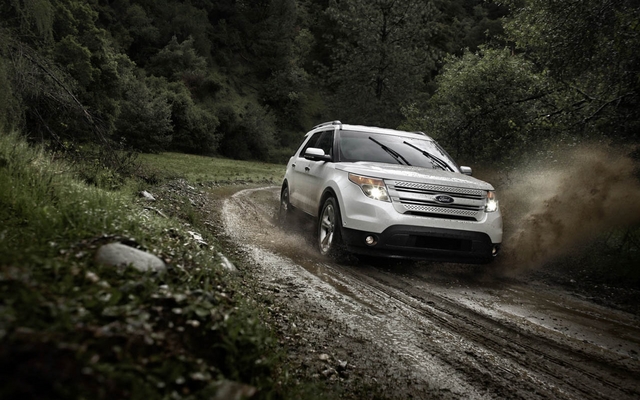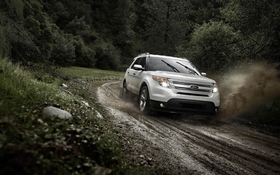2011 Ford Explorer: Reinventing the Wheel

| Strong points |
|
|---|---|
| Weak points |
|
By now, you may have heard that the single most important SUV ever produced by mankind has been reinvented. If you haven’t, you’re probably deaf, in which case you’ve probably already read about it.
Ok, so that may be a bit of a hyperbole. After all, the Land Rover Defender and Toyota Land Cruisers; both extensively used by UN, peacekeeping, and humanitarian organizations are technically SUVs, just as is AM General’s venerable and oh-so-recognizable HMMVW/Hummer. But while those vehicles have quietly gone about changing the course of history, the Ford Explorer has shaped what most North Americans think of as the prototypical SUV. Be it a term you associate with Firestone tires and rollovers, or family camping trips and driving lessons, there aren’t many badges on the market that carry as much cachet as the Explorer.
And with all the work that’s gone into this latest one, it should definitely be a boon to an already strong nameplate. Bearing nothing in common with the old, body-on-frame behemoth that bore the same name, this new vehicle set itself apart right from the get-go, when Ford’s executives decreed that the next Explorer would bring unibody construction to the full-size SUV market, just as the ’64-1/2 Mustang brought the same technology to the ponycar world. Allowing engineers to experiment with more modern design technologies, the resulting vehicle is roughly 200 pounds lighter than the old one, but almost 1,500 pounds lighter than one of its chief competitors, the Chevy Tahoe.
And you can definitely tell, both in the bends and at the pumps. Obviously, the independently sprung Explorer’s ride is undeniably better than any body-on-frame SUV could hope to match, giving great roadholding ability without translating offset road undulations and bumps into awkward wiggles. And the powerplants, although diminutive by comparison, propel the shapely SUV-cum-Crossover with enough verve to satisfy all but the tardiest of soccer moms. Currently offered with a 3.5L V6 that lends itself well to low-rpm duties such as towing and backroad exploration (pun very much intended), fuel economy was surprisingly good, but it’s the upcoming 2.0L, turbocharged four cylinder that has me most interested. Producing 237 horsepower to the big V6’s 290, and 250 pound-feet of torque to the V6’s 255, it should be one hell of a combination. Much like the EcoBoost V6 that’s impressing Ford F-150 buyers the world over, one can expect the EcoBoost four-pot to literally revolutionize the SUV market; silencing those that clamor for bigger displacement motors and educating drivers on the benefits of well-tailored horsepower and torque curves. And the best news? Ford claims the EcoBoost-equipped Explorer will consume just over 8 litres per hundred kilometers.
Then again, maybe I’m wrong. Maybe that awesome little engine isn’t the best news… maybe it’s the new interior. Taking a cue from the car-like underpinnings, the interior designers ensured that everyone would find the interior of their Explorer just as user-friendly and comfortable as any Toyota Camry or Honda Accord ever made. The seating position is anything but truck-like, and that helps the relatively large Explorer feel much less intimidating from the driver’s seat. Moreover, giant windows in every direction reduce blind spots to nil, and excellent side view mirrors and the now-ubiquitous rear-view camera system make backing up a breeze. But it’s not all conventional family sedan, either. No, perhaps the coolest part of the Explorer’s interior is also the newest part: an inductive panel that replaces the standard array of buttons on the console. Working much like the touch screen on your iPhone or tablet of choice, the console responds to fingertip pressure with a telltale noise, but does without the moving parts of a button that can wear and trap grime.
But it’s not all butterflies and rainbows. No, be it as a result of that new touch-sensitive panel or simply the new Sync system’s rapidly growing list of features, the on board infotainment system has a pretty decent amount of lag to it sometimes… like when you’ve just gotten into the freezing cold car and are desperately stabbing away at the touch screen to A) get to the climate control screen, B) select the right seat, and C) turn on the applicable seat heater. Likewise, the steering wheel, although perfectly serviceable with a wide array of features, feels a little chintzy when you run your hand over the matte silver trim. And then, finally, you have the panel fitment. Now, before I mention this part, I want to make it abundantly clear that the Explorer given to me for testing was, in the very least, a very, very early production model. That said I haven’t seen such mismatched gaps in a very long time. Inside, the worst offender was definitely the passenger side door panel, which seemed to sit half an inch or so higher than the dashboard. Normally, this wouldn’t be that noticeable, but the Explorer’s new car-like interior features a wraparound dashboard contour that should run, uninterrupted, onto the door panel. It didn’t. Similarly, the rear hatch seemed to sit a little bit depressed within its opening, causing the gaps between the hatch and the quarter panels to look a bit larger than Ford probably intended.
However, as I said, this was an early production run of a brand new vehicle, and hiccups are to be expected, just as they are expected to be remedied. Would they stop me from considering a new Explorer for my driveway? Hell no. Would I be checking a potential purchase from top to bottom for the same issue? Hell yes.
But all panel gap discussion aside, the new Explorer is, overall, possibly the most revolutionary vehicle Ford has put out since the brand’s re-invention under Alan Mulally. Sure, the Fusion Hybrid made quite an impact (as did the Fusion, actually), and the Fiesta and Focus are media darlings, but none of those vehicles truly reinvented an entire market segment quite like this does. Leaner, more purposeful, easier to use, and much more suburb-oriented, it’s what most SUVs should have become years ago. But it’s somewhat fitting that the Explorer, the epitome of the sports utility vehicle, should be the first to make the jump. It is, after all, the most important SUV on the planet, right?











